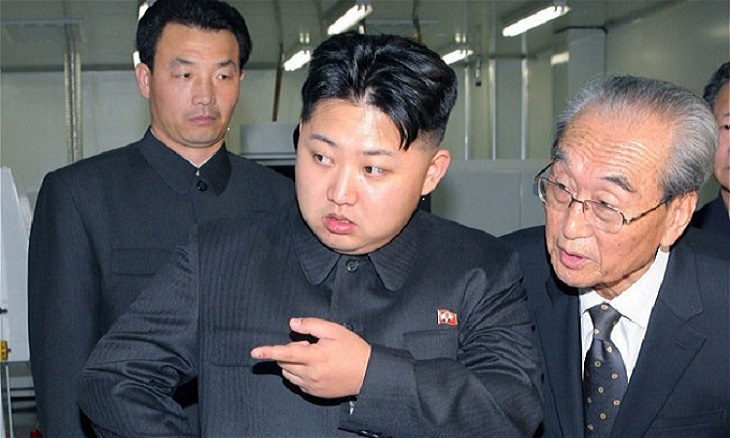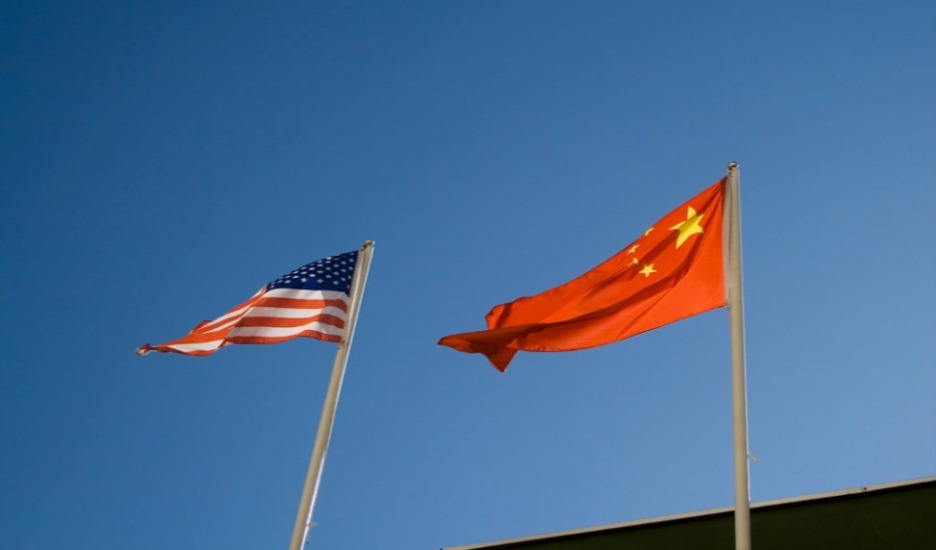The North Korean Missile Launch, the Assassination of Kim Jong-nam, and the U.S.-China Relationship
Kim Jong-un has had a busy two weeks. On February 12th, North Korea launched a ballistic missile into the Sea of Japan during Japanese Prime Minister Shinzo Abe’s visit to the United States, prompting an unusually public flurry of response at President Trump’s Mar-a-Lago estate. Then, on February 13th, Kim’s half-brother Kim Jong-nam was assassinated under bizarre circumstances in a Malaysia airport. And on the 19th, China announced a halt in North Korean coal imports for the remainder of 2017.

Published by The Lawfare Institute
in Cooperation With

Kim Jong-un has had a busy two weeks. On February 12th, North Korea launched a ballistic missile into the Sea of Japan during Japanese Prime Minister Shinzo Abe’s visit to the United States, prompting an unusually public flurry of response at President Trump’s Mar-a-Lago estate. Then, on February 13th, Kim’s half-brother Kim Jong-nam was assassinated under bizarre circumstances in a Malaysia airport. And on the 19th, China announced a halt in North Korean coal imports for the remainder of 2017.
In this post, I examine each of these three events before turning to the inevitable question of what comes next. The bottom line: with South Korea distracted by the impeachment of Park Geun Hye, these issues center as much on the U.S.-China relationship as they do on North and South Korea.
The Missile Launch
Missile tests have two objectives, both in the signaling value of the test and in the test itself. The signaling motive in this case was pretty clear. The struggling Trump administration had had a pretty good ten days with respect to Asia: a successful trip by Secretary of Defense Mattis to Korea and Japan; the restatement of the one-China policy with President Xi, even if under some duress; and the Abe summit. The Mar-a-Lago summit had a number of strange moments (link is external), but it nonetheless affirmed the alliance. Why not throw cold water on the meeting by reminding everyone that North Korea is still there?
But missile tests are not just for show; they are ultimately about the development of capabilities. The acceleration of North Korea’s testing under Kim Jong-un—neatly documented in an infographic from the CSIS Missile Defense Project—has both quantitative and qualitative dimensions. The numbers are straightforward: four tests in 2012, eight in 2013, 18 each in 2014 and 2015 and 23 in 2016. The majority of these 70 tests—42—have been short-range Scud variants. But in 2016, the tests included the long-range “satellite” launch in February, a succession of tests of intermediate-range Musudan missiles (at least one of which succeeded), an intermediate-range Nodong that landed within 125 miles of Japanese waters, and several submarine-launched ballistic missile tests, as well as a ground test of a new rocket engine. A crucial aspect of these tests is the shift from liquid- to solid-fueled engines. John Schilling explains the implications:
[Solid fuel rockets] require little maintenance, can survive rough handling and off-road transport, are less prone to leaking toxic, corrosive vapor at the slightest provocation, and even the largest solid-fuel missiles can be launched on a few minutes’ notice. That last characteristic is going to be particularly important for North Korea, as South Korea’s missiles can reach targets anywhere in the North in the fifteen minutes or so it would take to fuel and ready a liquid-fuel missile for launch.
Solid-fuel thus contributes to survivability, in part through mobility. (Last week’s launch was conducted using a vehicle known as a transporter erector launcher, which, as the name suggests, is used to transport missiles.) But it also moves the crisis management game into a more knife-edged state in which anticipation of attack could lead to “use ‘em or lose ‘em” calculations. And this, of course, is on top of the two recent nuclear tests.
There was initially some confusion about the nature of the missile being tested, but statements from the South Korean Joint Chiefs covered in detail by NKNews suggest it was a submarine-launched ballistic missile: a so-called Pukguksong-2 that is related to the Pukkuksong-1 SLBM launched with apparent success in late August. The test thus not only contributes to the cold launch of such a system—in which the missile is launched from a submarine by being ejected to the surface using high-pressure gas. It also contributes to the march toward solid fuel rocketry and thus Pyongyang’s continued pursuit of a militarized version of the Unha satellite launch vehicle, in effect an ICBM.
The fact that the missile was not of longer range appeared to obviate the “red line” problem created by the president’s intemperate “won’t happen” tweet. And even more importantly, the test activated the hidden lineaments of the alliance, including a Trump statement of support for Japan (although not South Korea), a phone call between then-National Security Advisor Michael Flynn and his South Korean counterpart, Kim Kwan-jin, and a joint call by the U.S., Japan and Korea to convene a Security Council meeting.
If that is the good news, the bad news is that the test is not just a diplomatic-political signal. It is rather another step in the development of the country’s missile capabilities, which have continually been underestimated.
The Assassination of Kim Jong-nam
The Kim regime has a history of assassinating and attempting to assassinate its opponents, whether they be South Korean leaders, North Korean officials who’ve fallen from grace, or defectors. These killings extend to family members as well, most recently including the 2013 execution of Kim Jong-un’s uncle Jang Song-thaek.
Kim Jong-nam, the older half-brother of Kim Jong-un, was once groomed to be the next leader of the DPRK but fell from grace and has been living in Macau and Beijing, where he was provided diplomatic protection. Although generally low-key, Kim Jong-nam had criticized hereditary succession (and hence the legitimacy of his little half-brother’s rule) and voiced his support for reform in the DPRK. Kim Jong-un never forgave him for these transgressions. According to South Korean intelligence, Kim Jong-nam sent a letter to Kim Jong-un pleading for his life in 2012 and the regime had a standing order on his head.
The bizarre assassination story involves two assassins poisoning Kim Jong-nam in the budget lounge of the Kuala Lumpur airport. Kim Jong-nam immediately sought medical and police attention but was declared dead en route to the hospital. Thus far, two women—one with a Vietnamese passport, the other with an Indonesian passport—have been detained, along with the boyfriend of the Indonesian passport holder as well as a North Korean. It is suspected that four North Koreans involved in the plot got away, but two more—including an embassy official—did not get out of the country and are being sought by Malaysian authorities.
In the absence of any evidence, theories abound. If the assassination was carried out under a standing order, timing is not really relevant: this could be a matter of seizing an opportunity. On the other hand, the decision to pull the trigger could signal nervousness in Pyongyang. The last year has seen some unsettling defections, from a bevy of waitresses to diplomat Thae Yong-ho from the London embassy. Rumors have surfaced that Kim Jong-nam was considering defection, perhaps because of financial difficulties. This would have been extraordinarily embarrassing for the regime.
Another theory is that Kim Jong-nam was being held in reserve as a possible candidate for regime figurehead by the Chinese in the case that things in Pyongyang fell apart.
Or the hit could reflect something altogether more mundane, such as a struggle over money or connections to the Malaysian underground. Kim Jong-nam had assisted in the movement of the regime’s money in the past, and the assassination is certainly going to open up closer scrutiny of how North Korea is using Southeast Asia as a lifeline to the world economy.
The most interesting questions center on how this event will be viewed in China. The assassination of Jang Song-thaek was a serious affront given that he had managed China-DPRK relations. We do not have any evidence that Kim Jong-nam was a go-between for the Kim Jong-un regime with respect to China. He seemed to fit more closely the dissolute elite playboy model, showing up in expensive venues now and then. If the Chinese did feel that they were granting him protection, it would be an ironic turn given how they have been behaving toward their own nationals abroad.
The assassination was a warning to elite North Korean leadership to toe the line or end up like Kim Jong-nam. The debate since Kim Jong-un came into power and engaged in successive purge cycles is whether they signal that he has a full grasp on power or is lashing out in weakness. I side with the former view—that purges consolidate power—but this one is going to leave some diplomatic messes with both China and Malaysia in its wake.
The Coal Ban
A week after the assassination of Kim Jong-nam, in a terse statement on the Ministry of Commerce website—with no supporting documents—Beijing announced that it was suspending further coal imports from North Korea through the end of the year. If this is for real, then we are about to see a real test of a proposition I have been offering for some time: that the North Korean economy is more vulnerable to Chinese pressure than is thought. North Korea is not immune from the laws of economics, and could easily experience a full-blown balance-of-payments-cum-currency crisis, with the black market value of the won plummeting rapidly and domestic prices spiraling in tandem.
But before we get too excited, the outcome of this episode will depend not only on whether China follows through, but on the politics of the move. If China is squeezing North Korea, it is for one purpose and one purpose only: to offer a cooperative gesture to the incoming Trump administration in return for an initiative on negotiations. The key question is whether the US can pick up on the offer given the transition and the answer could well be “no.”
There is still some confusion about whether China’s move is in line with UN Security Council Resolution 2321—passed after the fifth nuclear test—or a stronger signal still of the regime’s displeasure. As I explained in earlier analysis of U.N. Security Council Resolution 2321, the resolution did not in fact impose a coal ban. Rather, it put a complex cap in place, which would ultimately impose about a $500 million hit to roughly $900 million of coal exports over the full year. We will not know for another month or so whether China actually imported all of quota in the first six weeks of the year—thus requiring the halt under 2321—or whether they simply decided to impose a deeper restriction on the country’s exports.
And there is the question of whether China is serious and will stick to the commitment just made. Last year, U.N. Security Resolution 2270 purportedly imposed an import ban, but was riven with a livelihood exemption that allowed North Korean exports to China over the year to trend up. And only two weeks ago, Kent Boydston and I showed that following the announcement of a coal ban for the remainder of the year on December 10, 2016, China actually ended up importing more coal in December than it had in any other month of the year. David von Hippel and Peter Hayes have a very strong analysis of how China could go wobbly if it chose to, and that is quite apart from possible smuggling and diversification of export markets.
What Now?
Whatever Kim Jong-un’s intentions, the last round of North Korea news is not doing the regime any good. The firing of a missile while Japanese Prime Minister Abe was visiting President Trump at his personal estate will push the U.S. and Japan closer together. And the assassination just re-enforces the image of the regime provided by the United Nations’ Commission of Inquiry report in 2014: a cruel and ultimately capricious dictatorship that cannot be trusted on anything.
My favored explanation of China’s behavior is that does not have to do as much with North Korea as it does with U.S.-China relations. It is no mystery that China was frustrated with the Obama administration’s “strategic patience” approach, which put the onus for progress on a North Korean move back to the negotiating table. To understand the meaning of this gesture, it is important to understand China’s overall posture, which is easily summarized in four bullets:
- Strong and principled declaratory opposition to North Korea’s nuclear program;
- Willingness to support sanctions that are narrowly targeted at the WMD program, while effectively propping the country up through ongoing commercial trade and investment;
- Opposition to any actions that would create “instability” on the peninsula, meaning not only military conflict but instability of the regime itself;
- Insistence that concessions from the U.S.—including a willingness to negotiate—are the key to resolving the puzzle, rather than Beijing’s own enabling behavior.
It is this last bullet that now will pose challenges to the Trump administration. The objective of the coal ban is clearly not to bring down the North Korean regime. As with both U.N. Security Council Resolutions 2270 and 2321, the Chinese objective in supporting sanctions was to return to some kind of talks that would move a wider settlement forward. In his conversation with Foreign Minister Wang Yi last week, Secretary of State Tillerson reportedly urged China to use all available tools to moderate North Korea’s behavior, presumably including diplomatic action and sanctions. But Wang Yi similarly pressed Washington to figure out how to get to talks.
If the underlying purpose of this gesture was to shift pressure back on to Washington, how will the Trump administration respond? The president’s walking back from his one-China probe was a necessary condition for U.S.-China cooperation on this and other issues, but hardly sufficient. The willingness of the Trump administration to negotiation will depend on whether the North Koreans are capable of uttering the words “denuclearization.” If not, it is hard to see how this would move forward. But if they do, I honestly hope that the new administration grabs the opportunity. There is plenty of advice out there about exactly how to do it, most recently by John DeLury at Foreign Affairs and by an Asia Society task force report headed up by Orville Schell and my colleague Susan Shirk. We will also have more information on the Trump administration’s views later in the week. A track-two diplomatic exercise organized by Donald Zagoria out of New York will seek to bring North Korean officials to the U.S. If the officials are granted visas, this could show openness to dialogue of some sort.
But the Chinese will need to be patient, and hope that the timing works out so that the diplomatic channel will engage before they are forced to backpedal because of distress in North Korea. And finally there is the problem of how North Korea will respond. If the coal ban really bites—probably later in the spring when food supplies dwindle—they will have only one card: further nuclear and/or missile provocations. I expect them to play this card, making conciliation more complicated for both China and the United States.


.jpg?sfvrsn=5a43131e_9)


